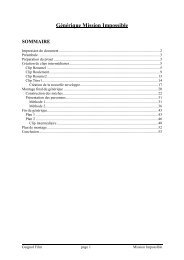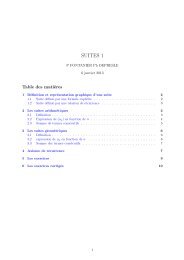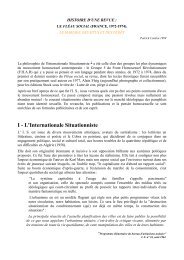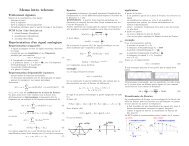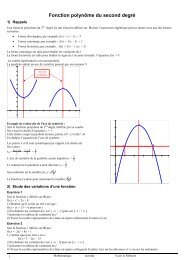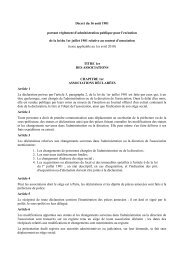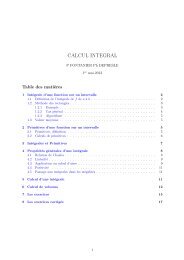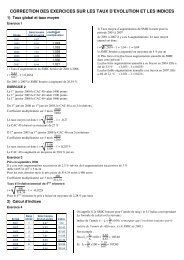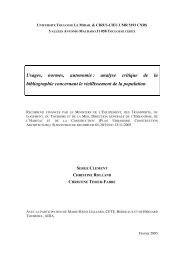internationalisation in science in the prism of bibliometric indicators
internationalisation in science in the prism of bibliometric indicators
internationalisation in science in the prism of bibliometric indicators
Create successful ePaper yourself
Turn your PDF publications into a flip-book with our unique Google optimized e-Paper software.
market is concentrated with<strong>in</strong> operators, commercial publishers and/or<br />
societies, <strong>in</strong> a few countries (first <strong>of</strong> all <strong>the</strong> UK, <strong>the</strong> US, <strong>the</strong><br />
Ne<strong>the</strong>rlands). Most publishers promote <strong>in</strong>ternational journals, sometimes<br />
by merges between complementary national media e.g. to form "European<br />
journals". Researchers tend to select a journal for <strong>the</strong>ir publications<br />
<strong>in</strong> terms <strong>of</strong> <strong>in</strong>ternational visibility and citation rewards ra<strong>the</strong>r than<br />
national audience, as far as primary communication is concerned<br />
(transfer literature is ano<strong>the</strong>r question, see also <strong>the</strong> chapter by<br />
Lewison).<br />
2. National-orientation <strong>of</strong> journals: static measures<br />
The <strong>in</strong>ternational model predicts that journals, as spaces <strong>of</strong><br />
competition for <strong>the</strong> authors, and <strong>the</strong>mselves <strong>in</strong> competition, should<br />
<strong>in</strong>creas<strong>in</strong>gly welcome authors from various orig<strong>in</strong>s, and f<strong>in</strong>ally reflect<br />
<strong>the</strong> <strong>in</strong>ternational pr<strong>of</strong>ile <strong>of</strong> <strong>the</strong>ir scientific speciality <strong>in</strong> <strong>the</strong> world<br />
ra<strong>the</strong>r than <strong>the</strong>ir mo<strong>the</strong>r-country production. This deviation to <strong>the</strong><br />
<strong>in</strong>ternational pr<strong>of</strong>ile <strong>of</strong> <strong>the</strong> discipl<strong>in</strong>e/speciality, used as <strong>the</strong><br />
reference, operationalises "relative <strong><strong>in</strong>ternationalisation</strong> measures" <strong>of</strong><br />
<strong>in</strong>dividual journals (Zitt & Bassecoulard., 1998a). 3 A journal will be<br />
termed "<strong>in</strong>ternational" (static def<strong>in</strong>ition) if it reflects <strong>the</strong> national<br />
balance <strong>of</strong> <strong>the</strong> reference set at a given time. Many variants <strong>of</strong><br />
<strong><strong>in</strong>ternationalisation</strong> <strong>in</strong>dexes can be proposed, for example by us<strong>in</strong>g a<br />
regional (geopolitical zones) breakdown <strong>in</strong>stead <strong>of</strong> a national<br />
breakdown, 4 by <strong>in</strong>troduc<strong>in</strong>g a stratification by impact levels, by<br />
pick<strong>in</strong>g different statistical <strong>in</strong>dexes, relative or absolute. 5<br />
Correlation <strong>of</strong> <strong><strong>in</strong>ternationalisation</strong> <strong>in</strong>dex with journal impact is quite<br />
moderate (Bassecoulard & Zitt, 2004). 6 These families <strong>of</strong> <strong>in</strong>dicators can<br />
be extended to <strong>the</strong> study <strong>of</strong> <strong>the</strong> national pr<strong>of</strong>ile <strong>of</strong> authors cit<strong>in</strong>g <strong>the</strong><br />
journal, <strong>of</strong> authors cited by <strong>the</strong> journal, <strong>of</strong> editorial committees<br />
(studied for example by Braun & Bujdoso, 1983, see also <strong>the</strong> chapter by<br />
Braun). O<strong>the</strong>r measures, <strong>bibliometric</strong>s-based or not, <strong>in</strong>clude <strong>the</strong> scope<br />
3 Relative measurement are sensitive to artefacts <strong>in</strong> <strong>the</strong> delimitation <strong>of</strong> <strong>the</strong> reference,<br />
especially: <strong>the</strong> def<strong>in</strong>ition <strong>of</strong> <strong>the</strong> perimeter <strong>of</strong> specialities or discipl<strong>in</strong>es; <strong>the</strong><br />
coverage <strong>of</strong> <strong>the</strong> database. For example, strong biases <strong>in</strong> <strong>the</strong> coverage <strong>of</strong> SSCI and<br />
A&HCI <strong>in</strong> some discipl<strong>in</strong>es prevent relative measurements, for lack <strong>of</strong> sound reference<br />
<strong>in</strong> <strong>the</strong>se discipl<strong>in</strong>es.<br />
4 For example, many European journals result from merg<strong>in</strong>g <strong>of</strong> national journals from two<br />
or more countries (ex. Astronomy and Astrophysics, European Physical Journal...).<br />
Undoubtedly <strong>the</strong>se were "<strong>in</strong>ternational journals" at <strong>the</strong> time <strong>the</strong>y were created.<br />
Today, depend<strong>in</strong>g on <strong>the</strong> way EU is considered (a mere club <strong>of</strong> countries or a real<br />
entity), a journal should probably be triadic or multi-cont<strong>in</strong>ental to be considered<br />
as truly <strong>in</strong>ternational.<br />
5 examples <strong>of</strong> <strong>the</strong> latter: number <strong>of</strong> dist<strong>in</strong>ct countries (<strong>of</strong> <strong>in</strong>stitutions) publish<strong>in</strong>g <strong>in</strong><br />
<strong>the</strong> journal; share <strong>of</strong> <strong>the</strong> country ranked number one; concentration <strong>in</strong>dexes <strong>of</strong><br />
author<strong>in</strong>g countries <strong>in</strong> <strong>the</strong> journal (for a review <strong>of</strong> <strong>the</strong> use <strong>of</strong> concentration <strong>in</strong>dexes<br />
<strong>in</strong> a <strong>bibliometric</strong> context see Egghe & Rousseau, 1990). The absence <strong>of</strong> term <strong>of</strong><br />
comparison <strong>in</strong> such <strong>in</strong>dexes can lead to undesirable results for journal assessment.<br />
6 Although <strong>the</strong>re is a large overlap between top (respectively bottom) classes <strong>of</strong> impact<br />
and <strong><strong>in</strong>ternationalisation</strong>. Besides, <strong>the</strong> correlation between <strong>the</strong> level <strong>of</strong><br />
<strong><strong>in</strong>ternationalisation</strong> and <strong>the</strong> level <strong>of</strong> co-authorship (rate <strong>of</strong> co-authorship <strong>in</strong> <strong>the</strong><br />
journal) is lower than +0.5 <strong>in</strong> most discipl<strong>in</strong>es.



